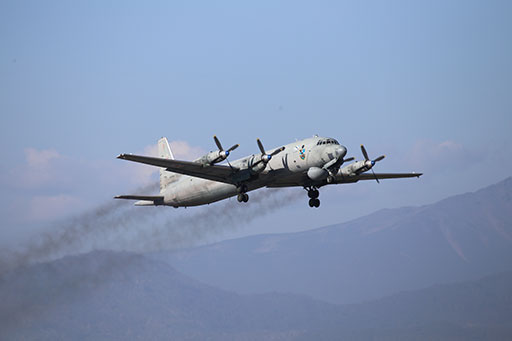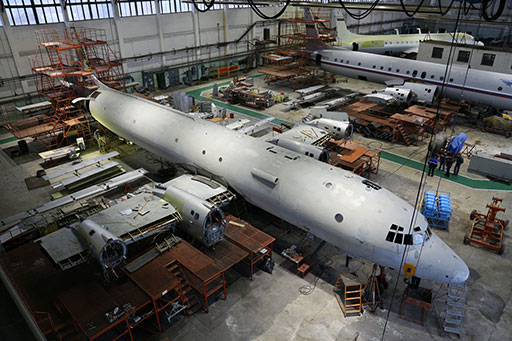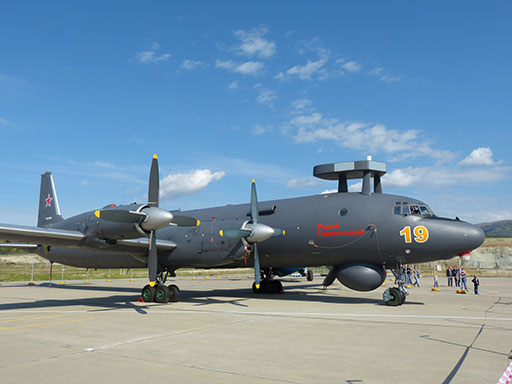David Oliver finds out how Russia’s 20th Aircraft Repair Plant has changed during its over 100 years of providing military aircraft MRO.

Russia’s oldest pre-Revolutionary repair plant continues to provide MRO services to Russian front line military aircraft 100 years on.
In 2016 the strategic partner of Russia’s Ilyushin Aviation Complex, the 20th Aircraft Repair Plant located at Pushkin on the outskirts of St. Petersburg celebrated its 100th anniversary.
On 20 August, 1916 plans for the construction of an aviation workshop and test laboratory were put before the pre-revolution Imperial Russian Council of Ministers. The project received the ‘highest level of approval’ and on 24 August, 1916 a secret order for fleet № 176 was issued. The home station for the facility was on the eastern dike of Grebnoy Harbour in the port of Vasilievsky Island in Saint Petersburg. The first aircraft to be repaired at the plant included the experimental Gakkel-3 and Gakkel -7 biplanes, the YuN-30, a Russian-built Farman F-30, Dornier Val flying boats, D.P. Grigorovich М-5, М-9 and М-11 flying boats, and I.I. Sikorsky designed S-6А and S-10. Between the wars Soviet Beriev МBR-2 reconnaissance flying boats, Polikarpov U-2 biplane trainers, giant ТB-3 bombers, and the Tupolev SB light bombers were repaired at the plant in what was then Leningrad.
During the Great Patriotic War a total of 2,117 aircraft, 1,429 aero engines, and 1,582 propellers were repaired in spite of the three-year long siege of Leningrad. Practically all the types operated by the Soviet Air Forces were repaired or modified by the workers and engineers at the 20th Aircraft Repair Plant. These included the Ilyushin Il-2 and DB-3F, and Petlyakov Pe-2 light bombers, and Polikarpov I-16, Yak-1, Yak -7Б, Yak -9, MiG-3, LaGG-3, Pe-2, I-2, and Lavochkin La-5 fighters.
After the end of World War Two it was necessary for a considerable amount of hard work to be undertaken to reconstruct the damaged facility, install new equipment and to train new technical staff to replace those lost during the war. At the same time it was expected that the facility should continue to repair and upgrade of aircraft, engines, weapon systems and other aviation equipment for the Soviet Air Forces and Navy.

On 1 August 1955, the aircraft maintenance centre was renamed Naval Workshop No 20 and with new jet-propelled aircraft entering service, new specialist equipment was required to deal with the more complicated engines. The facility was expanded to accommodate large multi-engine aircraft including the Naval Aviation’s Beriev Bе-6 flying boat.
The facility was again expanded in 1964 in order to overhaul and modify the Tupolev Тu-16 four-jet strategic bomber. The plant undertook the long complicated task of repairing and converting Naval Aviation Tu-16Ks to the Тu-16К-10-26 variant, 62 of which were rebuilt to launch centerline AS-2 ‘Kipper’ cruise missiles and two AS-6 ‘Kingfish’ anti-ship missiles. At the same time the plant began to undertake military conversion of Ilyushin Il-14, Il-18 and Tu-124 transport aircraft.
Currently, the 20th Aircraft Repair Plant comprises a complex of heated hangars, production workshops and warehouse buildings employing, highly qualified specialist staff with many years of work experience. The enterprise is equipped with non-destructive test (NDT) benches for primary aircraft elements, the testing of hydraulic, fuel and other systems. Repairs and modification of radio electronic equipment and avionics are also carried out.
In 2014, the 20th Aircraft Repair Plant was contracted by state defense order to overhaul nine Russian Naval Aviation Su-33 ‘Flanker-D’ aircraft at a cost of RUB1.03 billion (around U.S. $17.46 million) . Deliveries of three overhauled Su-33s per year were scheduled to begin in 2014 but due to financial problems, this schedule was delayed until 2016. Based on plans for the deployment of the Su-33s for participation in the war in Syria, the upgrade included the installation the SVP-24 Hephaestus targeting system.
However, due to its close relationship with the Ilyushin Aviation Complex the plant is heavily involved in extending the lives of the various Il-18 variants that continue to be operated by the Russian Air Force and Navy. A small number of Il-18 ‘Coot-A’ transport aircraft are operated by the Russian Air Force alongside 25 Il-20 and Il-22 ‘Coot-B aircraft, while the Russian Naval Aviation flies a mix of ‘Coot-A/Bs’ in the transport and electronic warfare (EW) roles and a fleet of 25 Il-38 ‘May’ anti-submarine aircraft.
The Indian Navy launched an upgrade programe to extend the life of its fleet of five ex-Russian Navy Il-38s that it acquired in 1975. A U.S. $150 million contract was signed in September 2001 for Russia to modernize the aircraft. The Leninets Institute of Russia, also located in St Petersberg, was given the task of fitting its Sea Dragon multi-mission avionics and electronic warfare (EW) suite and the 20th Aircraft Repair Plant would check and upgrade the airframes and engines prior to fitting of the new system. The first aircraft arrived in Russia for the upgrade on 29 March 2002 and returned to India on 15 January 2006. This modernization was to allow the aircraft to remain operational for another 15 years.

The airborne eyes of the Russian Navy belong to the ageing fleet of Il-38 aircraft. In response to the deployment of US Polaris nuclear submarines equipped with ballistic missiles, the Soviet Union began the development of the Il-38 long-range ASW aircraft based on the Il-18 four turboprop-powered commercial airliner. The first flight of the Il-38 prototype aircraft took place on 28 September 1961 and a total of 94 were produced. The aircraft were fitted with a magnetic anomaly detector (MAD) sensor tail cone, a Berkut hydro-acoustic sensor, J-Band Wet Eye radar in an underfuselage radome, and weapons bays ahead and behind the wingbox, for sonobuoys, homing torpedoes and depth charges.
Prompted by recent heightened East-West tension over Ukraine, an Il-38 modernization programme is being undertaken. The 20th aircraft Repair Plant is overhauling the Il-38 airframes and four 3,170 kW (4,250 shp) Ivchenko AI-20M turboprop engines before the systems are upgraded by the Ilyushin Aviation Complex.
The upgrade involves the installation of the new Novella-P-38 target search and track system. The fully digital Novella system is capable of detecting airborne targets at a distance of up to 90 km and surface targets up to 320 km. The system allows up to 32 targets to be kept in sight simultaneously, both above and under water.
The Novella system is fitted in a box-like structure mounted on three short pylons above the cockpit while an electro-optical/infrared (EO/IR) turret is mounted under the nose.
The upgrades will enable the Il-38N to conduct additional roles to ASW, these will include anti-surface warfare (ASuW), electronic intelligence (ELINT) and SAR as well as ecological monitoring. The first Il-38N aircraft began intensive flight trials at the Pacific Fleet air base of naval aviation at Elisovo in Petropavlovsk-Kamchatskyi.
In November 2016, the Russian Navy received two more upgraded Il-38N aircraft followed by another in February 2017 in addition to the initial five that have already been released for service under the initial RUB3.45 billion ($58.5 million) contract. The Deputy General Director of the Ilyushin Aviation complex, Yuri Yudin confirmed that under the contract with the Russian Defence Ministry, Ilyushin was to deliver a total of 28 Il-38N aircraft to the Russian Navy by 2025.
Russia completed the limited upgrade of the Indian Navy’s aircraft to Il-38SD standard by August 2015 but it is not expected that they will be bought up to Il-38N configuration due to their pending replacement by the Boeing P-8I Poseidon.
Recently the 20th Aircraft Repair Plant has checked and repaired three ‘Coot-B’ airframes prior to being converted to upgraded Il-22PP electronic jamming aircraft for the Russian Air Force.
While Russia’s oldest aircraft repair plant has a healthy backlog of work, it has shown it is not immune to the downturn in Russia’s economy. In April 2016 a local reporter interviewing President Putin asked why the workers at the 20th Aircraft Repair Plant in St Petersburg were not getting their salaries.
The president gave his assurance that they would all be paid in the near future.
